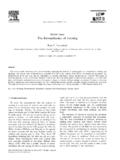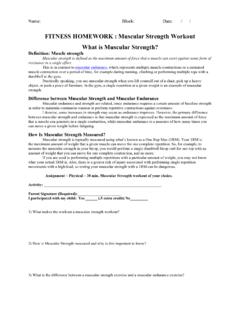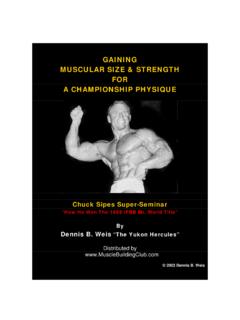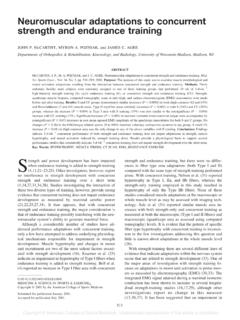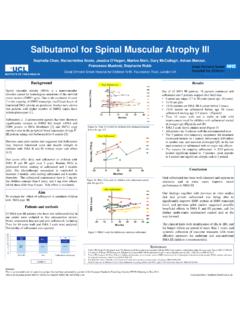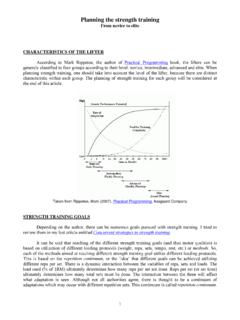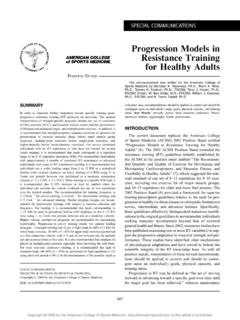Transcription of Explosive Exercise - ELITETRACK
1 Explosive Exercise Written by Mike Stone, Meg Stone, and Hugh Lamont Introduction Before discussing Explosive Exercise in detail it is necessary to define terms and present a theoretical background for the discussion. Of particular importance for this discussion are the concepts of strength , rate of force development and power. strength can be defined as an ability to produce force (Siff 2001, Stone et al 2001). Because force is a vector quantity, strength will have a magnitude and direction. The magnitude of strength output can range from 0 to 100% and the muscles involved determine the direction of force application. It is important to understand that strength can be "applied" using different muscle actions. strength is exhibited when muscles act to produce force. Muscle action can take different four different forms: Isometric in which the muscle gains tension but does not appreciably change its length Concentric in which the muscle gains tension and shortens Eccentric in which the muscle gains tension and lengthens Plyometric in which a concentric action is immediately preceded by an eccentric action, thus taking advantage of a stretch shortening cycle.
2 Muscle actions are supported by a number of different physiological and biomechanical mechanisms. The various mechanisms involved in muscular strength are listed in Figure 1. Two primary factors, which govern muscle activation and the gradation of strength are: 1) the number of motor units recruited and 2) the frequency of motor unit activation which can be termed "rate coding". These two factors normally work together in increasing force production. The exact degree to which one mechanism is emphasised over the other during muscle activation depends upon the amount of force required and perhaps the size and type of muscle being activated. Figure 1: Neuromuscular Factors Involved in strength Production There is doubt that an untrained muscle can be fully activated (Aagaard et al 2000; Semmler and Enoka 2000). Furthermore, strength training can result in a greater activation of muscle, thus influencing strength production.
3 Another mechanism, which can effect muscle force, is the synchronisation of motor units. Under normal low intensity muscle activation motor units fire asynchronously. However, as the maximum level of strength is approached some motor units are activated at exactly the same time as other motor units. Synchronisation is also a major factor in ballistic movements and will be discussed later. There is a great deal of evidence for the concepts of intra and inter muscular task specificity. Intra muscular task specificity deals with specific patterns of activation for motor units while inter muscular task specificity deals with the interplay and pattern of activation among muscles during a specific task. The concept of intra muscular task specificity may help explain the phenomena of regional hypertrophy (Antonio 2000), in which a specific Exercise may cause hypertrophy in one region of a muscle but not in others.
4 Bodybuilders have recognised this aspect of training arguing that in order to more completely develop a muscle, many different exercises for that muscle must be performed. Both intra and inter muscular activation patterns can change with very slight alterations in movement pattern, eccentric versus concentric actions or with changes in velocity (Semmler and Enoka 2000, Zajac and Gordon 1989). Because of these alterations in activation patterns, selection of exercises for strength /power training should be viewed as movement specific rather than simply training a muscle(s). Improvement in the efficiency of intra and especially inter muscular activation implies an enhanced coordinative ability and is an important mechanism contributing to improved strength expression (Semmler and Enoka 2001). The use of reflexes and stretch shortening cycles (SSC) can also alter the production of force (Bobbert et al 1996, Cronin et al 2000).
5 Basically a SSC consists of a plyometric muscle action in which an eccentric action immediately precedes a concentric action. The mechanisms involved in concentric enhancement may include: use of elastic energy, a stretch reflex, optimising muscle length, optimising muscle activation and muscle activation patterns (Bobbert et al. 1996, Bobbert 2001). Some evidence indicates that improving maximum strength can augment the concentric portion of the SSC (Cronin et al 2000). Learning to use a stretch shortening cycle more efficiently can markedly increase force production. The degree of neural inhibition can also effect strength capabilities. Inhibition can take two different forms conscious and somatic reflexive. Conscious inhibition deals with a perception (right or wrong) that a given weight may produce injury. For example, if you have never performed squats before and you are asked to perform a 300 kg full squat, chances are (if you are remotely intelligent) you will refuse.
6 Somatic reflexive neural inhibition, includes feedback form various muscle and joint receptors, and has been suggested to be part of a protective mechanism. This protective mechanism can reduce muscle tension during maximum and near maximum efforts. strength training appears to reduce receptor sensitivity, diminish inhibition and is partially responsible for the greater forces achieved (Aagaard et al. 2000). Motor unit type can also influence strength . Several studies have indicated that a large cross sectional area of type II muscle fibres may be advantageous in terms of dynamic force production (Powell et al 1984) even when muscle architecture and other mechanical factors are taken into consideration. strength training, particularly Explosive strength training appears to increase the ratio of type II:I muscle fibre cross section area in a manner favouring strength and power production.
7 Biomechanical and anthropometric factors such as gross muscle architecture, muscle insertion point, height, limb length and moment arm may alter the mechanical advantage of the intact muscle lever system. For example, weightlifters possess a high body mass to height ratio (Bm/h) compared to untrained subjects and other athletic groups. This Bm/h is advantageous because it can provide an increased force production. This advantage is associated with the strong positive relationship between a muscle's physiological cross sectional area and maximum muscle force generating capabilities (Semmler and Enoka 2000). If two athletes of different heights and different limb lengths have the same muscle mass and volume, the shorter athlete will have the greatest muscle cross section and therefore a greater muscle generating force. Of the various mechanisms dealing with absolute maximum strength , the most important is the physiological cross sectional area of a muscle.
8 From a practical standpoint, if cross sectional area were not the most important factor effecting absolute muscular strength then there would not be body weight classes in sports such as boxing, judo, wrestling or weightlifting. The relationship between strength and the physiological cross section area stems from the number of sarcomeres in parallel. The more sarcomeres in parallel the greater the maximum strength of a muscle. The process of hypertrophy, resulting from strength training adds sarcomeres in parallel thus raising the muscle's potential force production. Explosive Exercise Explosive Exercise can be defined as a movement in which maximum or near maximum rates of force development are attained. Explosive exercises can be either isometric or dynamic. Several factors contribute directly to Explosive Exercise these include muscle activation rate, and synchronisation.
9 Rate of Activation: An important factor, which effects the rate of force development, is concerned with the rate of muscle activation. Work by Viitasalo and Komi (1981) clearly pointed out that the rise in motor unit activation as measured by EMG is associated with a rise in muscle force. Evidence of this relationship can be observed in Figure 2 Note in that in tracing A the initial rate of activation and force development is higher than in tracing B. Thus, the rate of force development is largely a function of the nervous system's ability to activate muscle. Typically, high rates of force development are necessary for success in " Explosive and high power activities" such as sprinting, throwing and weightlifting. Synchronisation: At low muscle tension very little synchronisation is noted. Motor units typically are activated as brief "dynamic" twitches. Figure 3 depicts the asynchronous activation patterns of several motor units.
10 Note that during asynchronous activation when one motor unit deactivates another is being activated; this pattern creates a muscle tension production, which allows a relatively smooth movement to occur. Increased muscle activation through recruitment or rate coding can increase muscle force. As force output is increased greater levels of synchronisation can occur. The maximum frequency of activation can range from 30 50 htz for low threshold motor units, up to 100 htz for high threshold motor units depending upon the type and the intensity of the muscle action. Furthermore, strength training can enhance the number of motor units synchronising and can result in synchronisation at lower force outputs (Semmler and Nordstrom 1998). However, the degree to which synchronisation effects maximum strength , especially when measured isometrically appears to be minimal (Yao et al 2000).

